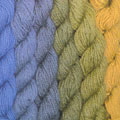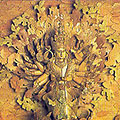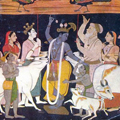
Natural Dyes, Pigments, Colours
Natural Dyeing with Plant and Mineral Matter: Cotton, Silk, Wool, and Leather
The art of dyeing in Nepal has an ancient past. Historic evidence based on a study of paintings and religious and cultural records indicates that natural dye-stuffs were used not only for the colouring of textiles and yarn for clothing, but also for dyeing yarn used in making tapestries. The collections of costumes, paintings, and tapestries that have been preserved in the stores of temples and monasteries in Nepal bear evidence to this.
PRACTITIONERS
Dyeing with natural materials was practised by the community of ranjitkars and chippas who lived and worked in Kathmandu Valley. In fact the presence of the chippa caste of dyers has been recognised by the Newari community of the Kathmandu Valley since the early part of the fourteenth century. These traditional artisans passed on their knowledge orally from generation to generation; there are few – if any – written records of their skills and recipes. Besides the professional dyers weaving and dyeing was also practised in many a home as part of the daily routine.
As the tradition of natural dyeing was almost completely an oral one – and also jealously guarded by its practitioners – the techniques used varied not only between one region and the other but also between one chippa and another.
MATERIALS USED
In the past dyers used many different fruits, herbs, barks, and leaves to prepare the various shades of colours. Some of the more commonly used fruits and herbs were: harro, barro (hala), dhamero ko phool (flower of the dhamero), bark of the kafal tree, and pomegranate rind. To fix the natural dyes to the fabric and to allow greater absorption of colour and increase its permanence a wide variety of mordant(s) were used by the dyers. Most often the mordant would be a metallic salt with an affinity with the dye colour and the material to be dyed. Some of these salts, like alum, were found in aluminous earth or rock scrapings. Mordant(s) present in fruits and plants – including lime and the Myrobalan fruit – were also popular. Other popular mordant(s) used included beer and salt.
Research by Bina Sreshtha in Dye Yielding Plants of Nepal (1994) indicates that over 170 plants possessing dye-yielding properties have been short-listed for use in Nepal. The unique topographical layout of the country and the varied vegetation in its different climatic zones (tropical, sub-tropical, temperate, sub-alpine, and alpine), determines some form of stratification for different species of dye-yielding plants, and provides opportunities for further study. With experimentation a whole new world of colours using natural dyes can be opened up.
COTTON & SILK (YARN & FABRIC)
- The best known and the most commonly used Nepali natural dye is madder (Rubia cordifolia Linn., (majitho) which yields colours ranging from orange-gold to deep red and light pink. The importance of madder for dyeing, both domestically and commercially, is indicated by the fact that the Sherpa word for ‘dye’ in general is tsoe, a word that is used interchangeably for madder; all other dyes have their own specific names. Traditionally, madder root, extracted mainly in the autumn months, is crushed and dried, mixed with an alum mordant, and used to dye the robes of Buddhist lamas. Its importance is indicated by the fact that in the nineteenth century it was bartered between the Tibetans and Nepalese in exchange for borax and rock salt.
- Also popular as a natural dye is the brown shade used for the dyeing of the commonly worn kogita textile. Traditionally, the colour of this light brown fabric is obtained from a species of the betel nut (higoye), the buds of the naranpati tree, ram tilak colours, and red clay, all infused in a copper vessel called phosi. The mordant used to make the brown dye for the kogita fabric permanent is an extract of citrus fruits such as lemon. The use of the copper phosi plays an important part in the dyeing process as the metal helps in brightening the colour(s) derived.
- The dye around which the most myths, traditions, and legends are built is the washi, a dark blue dye. A unique example of rock-dyeing, the washi is traditionally obtained in the form of hard clay from the Pharping area. This rocky substance is finely powdered, mixed with water, and preserved in earthen jars for several months. Often, the earthen jars in which the deep and rich blue colour brewed were preserved by the ranjitkars inside their homes – the chhipako ghyampo or the ranjitkar’s blue washi earthen jar was thus a long-standing tradition among the dyers in the Katmandu Valley. This clay jar has come to possess a ritual significance among the dyers as it was regarded as a symbol of ‘Bhairab’, the terrifying form of Lord Shiva. Worshipped by the dyer community during the dasain festival, special tributes are paid on the day of bijaya dasami, with the prasada or auspicious offering being made in the form of threads that are distributed to family, relatives, and friends. These earthen jars, traditionally a common sight in the Humata, Jaisidewal and Majipat localities of Katmandu and the Tangal and Sougal toles of Lalitpur, are now rare.
- The bark of the gular tree (Ficus glomerata Roxb) is used in preparing a deep black dye.
- In the Mustang region, the tinchu plant yields a pink and yellow colour, while the higway nut is traditionally boiled in water for 2 to 3 hours to yield a reddish saffron colour. Various other naturally occurring dyes made from locally available plants like padmachal, the bark of the okhar, walnuts, and the roots of the chulthe amilo are tradition dyes in this area.
- The bark of the soap nut plant, ritha (Acacia concinna DC), which grows in parts of the eastern, central, and western regions of Nepal has been used for dyeing and tanning fishing nets for generations. When an infusion of its leaves is combined with turmeric (haldi) it yields a green dye.
- The asuro (Adhatoda Vasica Nees) or Malabar nut is used for dyeing coarse cloth yellow; in eastern Nepal, the leaves of the lodh (Symploc Spicata roxb) are powdered and used to make a yellow dye.
- The bark of the English Yew (dhangre salla) is used in Nepal to produce a red dye; it is also used by the Brahmin caste of Hindus for marking their foreheads with their caste marks.
LEATHER
For dyeing leather, the yellow layer of the chutro plant (Berberis asiatica) a deciduous shrub is used. The thick stem of the thorny shrub is stripped and its green chlorophyll layer is removed with a knife. The interior yellow stem is scraped off and collected. It is then rubbed vigorously in water and this yields a yellow extract that is used to dye leather hides. The chutro shrub grows from 1,900-3,000m in areas that include Chepuwa and Tinjurey in the Koshi region, and Dhartigaon, Daman, and Ranipauwa in central Nepal.
WOOL
Dyeing of wool yarn with natural colours has been an age-old tradition in Nepal. With the influx of refugees from Tibet and the introduction of Tibetan carpet-weaving, natural dying of wool received an added impetus. Tibetan refugees and Nepalese citizens dwelling in the northern frontiers are considered exceptionally dextrous in preparing and using natural dyes. The natural dye is fast and durable and evidence can be seen in the carpets that are on display in museums all over the world.
- Traditionally, in Nepal, the dyeing of ram wool used for making the galaincha woollen carpets was done with a mineral blue dye known locally as ramje. The process of dyeing followed in the northern extremes of Nepal is arduous and complicated and has remained unchanged till today. The mineral clay that yields the dye is found in both the Mustang area and in western Nepal; it is extracted and powdered, boiled with local beer (jand) in a copper vessel, and then mixed with goat dung. This solution is allowed to ferment for about a month. Through this fermentation process a blue dye is obtained.The woollen yarn to be dyed is first cleansed with warm water to remove all impurities and then infused in the dye bath. The duration for which the wool is soaked in the dye solution determines the depth of the blue shade that is obtained. If a very light shade is to be imparted, the wool needs to be dipped only for a few minutes, whereas a deep-blue colour requires a half-hour soak. On being taken out of the dye bath, the wool is hung on wooden poles to dry in the sun and wind. The colour obtained is permanent.
- For a yellow dye, a flower that blooms in the Jomson and Marpha regions of the Mustang district is used. The flowers are collected, dried in the sun, and powdered. The powder is boiled with water, yielding a yellow dye. Prolonged soaking in the dye bath imparts a deep yellow colour, after which the wool is dried in the sun.
- The bark of the okhar tree is used in dyeing wool brown; this natural dye is traditionally used by radi-makers.
- The bark of the kalosiris (Albizzia lebbeck benth) or Indian walnut that is found in eastern, central, and western Nepal yields a shade of dark red when mixed with an alum mordant.
- The bark of the bhojpatra (Betula utilis D. Don) – the white Himalayan Birch tree found in eastern and central Nepal – yields a yellow dye when mixed with an alum mordant.
- For the dyeing of pakhi wool, sour milk (mahi) is boiled and a red dye added to it. Wool is immersed in this acidic solution and boiled for three hours in a brass vessel; this imparts a red colour to the wool. If the wool it to be dyed black, it is boiled with an aqueous solution of common salt and black dye. About two to three kilograms of common salt are required to dye 20 meters of pakhi wool.
- Some commonly used natural dyes – used for dyeing both wool and cotton – include the soma plant, whose roots yield a yellow colour, and the kilche roots that grow around Bagling, which, when crushed in a mortar along with the locally made wine and water, yield a shade of grey.
SOME INTERESTING USES OF NATURAL DYES
- The bhringraj (Eclipta alba Hassk) or daisy flower that grows all over Nepal is used not only for dying cloth black but also for imparting a rich black when the body is tattooed.
- The root of the bhanta plant (Geranium nepalensis Sweet), which grows in the temperate Himalayas is used both as a red dye for textiles and for colouring medicinal oils.
- The sigada (Trapa bispinosa Roxb.) is used for making red powder that is used during festivities.
A CONTEMPORARY PERSPECTIVE
Traditionally, there existed in Nepal a wealth of knowledge on the use of plant and mineral matter, not only for dyeing, but also for medicinal and other purposes. However, in the last few decades due to the increasing import of chemical dyes, the traditional art of natural dyeing was almost completely wiped out. In response to renewed interest, strenuous efforts are now being made to create a revival of this languishing art.
Gallery
YOUR VIEWS
PRACTITIONERS: INDIA
Access 70,000+ practitioners in 2500+ crafts across India.
BIBLIOGRAPHY
10,000+ listings on arts, crafts, design, heritage, culture etc.
GLOSSARY
Rich and often unfamiliar vocabulary of crafts and textiles.
SHOP at India InCH
Needs to be written.





